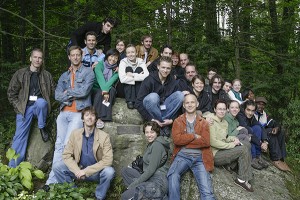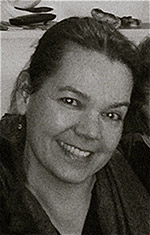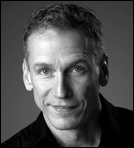Free Dance Workshops for All
Lots of happy faces at our You Can Dance workshop and Breakfast Download Discussion event this weekend.

Photos by Sharman Spieser.
Interested in more? See the full listing of upcoming free activities open to all levels.
Behind the Scenes with Hubbard Street Dancers
We caught up with the dancers from Hubbard Street Dance Chicago ahead of their performance of the works of choreographer William Forsythe in Ann Arbor.
Interested in more? Learn more about how William Forsythe changed ballet.
Dance Renegade: Choreography of William Forsythe
Editor’s note: As part of the UMS 21st Century Artist Internships program, four students interned for a minimum of five weeks with a dance, theater, or music ensemble part of our 2015-2016 season. Meri Bobber is one of these students. This summer, she was embedded with Hubbard Street Dance Chicago.
Below, Meri shares her travel stories with the company in advance of their return to Ann Arbor on October 27, 2015.

Photo: Moment in “Quintett” by choreographer William Forsythe. Photo by Cheryl Mann.
Meri’s note: My summer at Hubbard Street offered me some personal insight and experience with the work of world-renowned choreographer, William Forsythe. I met him and heard him speak at the company’s annual gala this June, researched his career as I helped write visa applications for his German restagers, experienced being in rehearsals with him and the Hubbard Street dancers, and conducted interviews about his work with Hubbard Street’s Meredith Dincolo, Glenn Edgerton, and Kevin Shannon. On October 27, Hubbard Street Dance Chicago brings a production of Forsythe’s choreography to Ann Arbor.
Forsythe’s History
American-born William Forsythe made his choreographic debut in 1976 after dancing professionally for companies including the Joffrey Ballet. He then went on to serve as the resident choreographer of Ballet Frankfurt in Frankfurt, Germany until its closing in 2004. He founded his own company, The Forsythe Company, with many of the same dancers and continues developing his work abroad.
Movement aesthetic
Forsythe is widely credited for radically rethinking and reinventing ballet. He uses balletic concepts such as épaulement (a type of shoulder movement) in many of his works, but infuses the foundational technique with new ideas and fresh contexts. His movement language explores the geometric possibilities of the body as it moves through space, challenges verticality, employs torsion and spirals, and explores lines, points, and curves. Hubbard Street’s Artistic Director Glenn Edgerton said in an interview this summer that Forsythe’s perspective and work “has changed the face of dance.” Retired Hubbard Street dancer Meredith Dincolo, now artistic associate and coordinator of pre-professional programs, added, “In classical dance and in contemporary dance, you can’t deny [Forsythe’s] importance.”
Forsythe as a collaborator
Forsythe’s work can be highly collaborative, academic, and technology-driven. He has developed his own computer software and improvisation technologies that explore geometrically influenced movement generation. Additionally, he has collaborated with The Ohio State University to create an interactive website which examines One Flat Thing, reproduced, one of the pieces that Hubbard Street will perform for our audiences. Forsythe’s work “made science and dance come together,” says Edgerton.
One Flat Thing, reproduced by William Forsythe from dance-tech.TV on Vimeo.
Creative process
Forsythe’s dancers are treated as essential collaborators throughout his creative process. On September 30, 2015, in a conversation with Hubbard Street’s Zac Whittenburg, Forsythe articulated that his choreographic process consists of giving his dancers the substantive ideas, shapes, tasks, and themes (the “what”). The dancers then bring these to life in the studio (the “how”). Those working to set the rep on Hubbard Street’s company are all dancers who participated in the original casts of the works. Glenn Edgerton believes the process of learning, rehearsing, and performing Forsythe’s choreography will “change and broaden [the Hubbard Street dancers’] perspective” on dance, influencing the rest of their careers. Hubbard Street dancer Kevin Shannon agrees. This summer, he said that he’s excited to focus on one choreographer’s work for several months, because especially with Forsythe, “it is all about the process.”
Future
Now 65, Forsythe is retiring as artistic director of The Forsythe Company and will soon be on faculty at the new Glorya Kaufman School of Dance at the University of Southern California. His educational efforts in America will begin to contribute to the propulsion of “what’s next” in American contemporary dance. The contemporary dance community of the United States is highly anticipating his return.
Forsythe in Ann Arbor
The William Forsythe program that Hubbard Street brings to Ann Arbor will restage three of Forsythe’s most impactful works: N.N.N.N., Quintett, and One Flat Thing: reproduced. This selection of works exemplifies Forsythe’s signature movement language while also proving his diversity as a choreographer as the three pieces vary greatly:
- N.N.N.N. is a quartet originally set on four male dancers. The HSDC restaging is challenging the role of gender and inter-gender relationships by substituting women into some of the roles. The choreography is precise and fearless and moves like mechanical clockwork. The dancers’ limbs intertwine and bounce off one another’s bodies as the group moves through space.
- One Flat Thing, reproduced was created in 2000, recreated on film in 2006, and was originally set on 14 dancers with 20 large, identical tables. The tables create grid-like negative space on stage, and the dancers maneuver over, under, and around this space in solos, duets, trios, and larger groups. The piece is a massive puzzle of visual and aural cues, and requires the dancers to pay explicit attention to one another’s timing. This is the kind of piece that’s always happening: if you blink while watching, you’ll miss something.
- Forsythe’s late wife inspired Quintett. Five male and female dancers move to exhaustion to the repetitive music of Gavin Bryars. The choreography exemplifies Forsythe’s geometric interests and explores grief by taking the dancers on a journey to a state of extreme physical fatigue. Hubbard Street dancer Kevin Shannon confirms that this is “one of the hardest pieces I’ve ever danced in my life… the state of exhaustion you reach creates a connectivity [with the other dancers] that you don’t see in other pieces. By the end, you have to let go and find a deeper place within yourself.” Meredith Dincolo describes Quintett as the most intimate of the works we’ll see, pairing well with the other pieces to give a “broad spectrum of William Forsythe’s work.”
Hubbard Street Dance Chicago returns to Power Center with an evening of works by choreographer William Forsythe on October 27, 2015.
Interested in more? UMS Artist Services Manager Anne Grove was once company manager of Hubbard Street Dance Chicago. Read our interview with Anne.
Student Spotlight: Embedded with Hubbard Street Dance Chicago
Editor’s note: As part of the UMS 21st Century Artist Internships program, four students interned for a minimum of five weeks with a dance, theater, or music ensemble part of our 2015-2016 season. Meri Bobber is one of these students. This summer, she was embedded with Hubbard Street Dance Chicago.
Below, Meri shares her travel stories with the company in advance of their return Ann Arbor on October 27, 2015.
Assume nothing; be curious. This approach to artistry is something I learned from choreographer William Forsythe at Hubbard Street Dance Chicago’s Spotlight Ball on June 1, 2015. The glamorous night was a celebration of dance and highlighted the success and impact of Forsythe’s work, as the main company prepared to perform his choreography in its upcoming season. By the night of the gala, I was already a few weeks into my internship, but I carried this advice with me as I continued my summer in Chicago as a UMS 21st Century Artist Intern.
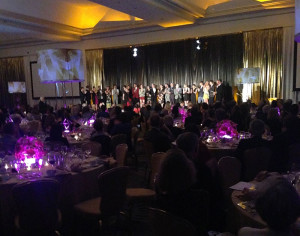

On left, the gala was held in a ballroom of the Fairmont Hotel in downtown Chicago. In this shot, dinner guests applaud as Artistic Director Glenn Edgerton introduces all the professional dancers of Hubbard Street. On right, Hubbard Street’s second company, comprised of early-career artists, perform a movement composition exercise to supplement the dance education of Chicago elementary school students.
My internship at Hubbard Street was structured so that I would rotate departments weekly for two months. This structure ultimately proved to be incredibly appropriate, as I saw firsthand that non-profit organizations require their employees to wear many hats, big and small, simultaneously, and to still maintain the ambition to learn on the fly, to jump in wherever he or she is needed. For example, the accounting manager at Hubbard Street also serves as IT. A former professional dancer of the company is now its Manager of Communication on the marketing team. When I joined the second company for a day of several dance outreach performances at Chicago area schools, the artistic director drove our van.
I practiced the same adaptability in my internship, beginning in artistic administration, where I was trusted with an important, ongoing project right away. One of the repetiteurs from The Forsythe Company was to come to Chicago and set three of William Forysthe’s works on the dancers for the performance Hubbard Street will bring to Ann Arbor in October. As an artist of German citizenship, he needed a visa for his work in Chicago. So, although I bounced around departments, I worked throughout my internship to research this repetiteur’s career, assemble resources, and write a coherent paper about him that proved the legitimacy of his trip and his work at Hubbard Street. I needed to present enough evidence to prove that he was the best and only man for the job. My supervisor worked closely with me on the project, taught me how to address the guidelines required by the government, and left me confident with a new, important skill. One of my highlights from the summer was the day that my supervisor informed me that the application had been accepted by the government. I met him in person later on, and his gratitude for my help with his application touched me. The work I had put into it proved successful for Hubbard Street and the Forsythe production.
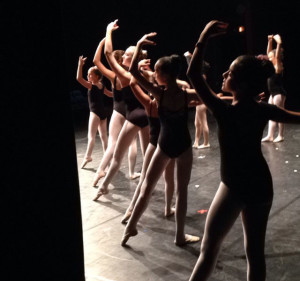
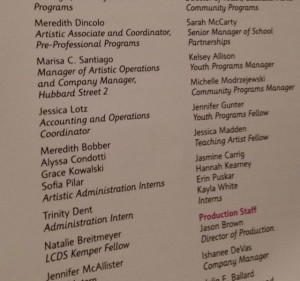
On left, a shot from backstage of the Hubbard Street Youth Showcase where I helped the professional dancers of tomorrow make it on stage in time for their numbers. On right, I spent the week leading up to Hubbard Street’s Summer Series at the Harris Theater helping out at dress rehearsals backstage. It was a treat to find my name included on the Hubbard Street Staff listing in the program on opening night!
I switched responsibilities each Monday. I served in the marketing department, where I initially felt far out of my comfort zone but ultimately learned a lot in just five days; the youth education department, where I made great friends with other interns and helped the youth showcase recital run smoothly; backstage of the Harris Theater downtown, where I assisted Hubbard Street’s main company manager during a production that featured the work of resident choreographer Alejandro Cerrudo; and the development department, where I learned about external affairs and donor profiling, and helped out behind the scenes at the aforementioned gala. And that’s just to list a few!
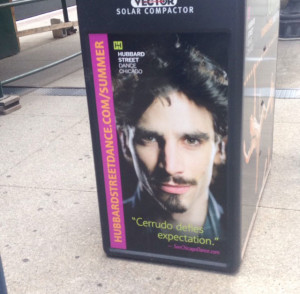

On left, Hubbard Street marketed the Summer Series show with ads like this all over street kiosks downtown. It was fun to learn about such marketing strategies at work, then go see them in action on my walks to and from the theater. On right, Hubbard Street’s Resident Choreographer Alejandro Cerrudo signed my program on closing night of the Summer Series.
Following the internship, I stayed on for a third month to participate in the college-level summer dance intensive. This is a program I enjoyed thoroughly last summer as well. I was happy to have Hubbard Street’s artistic staff, alumni, and current dancers give me another satisfying amount of choreography to study and a technical kick-in-the-pants. The training tested my adaptability as a dance artist, connected me with talented young dancers from around the country, and filled gaps in my technique. It was a special experience to come to the building every day and spend 8 hours in the studios just as Hubbard Street’s professional dancers do. I studied ballet, yoga, Pilates, improvisation, Gaga technique, Horton technique, partnering, and a variety of diverse repertory excerpts that required me to dance with different qualities and intentions. I sweat. A lot.
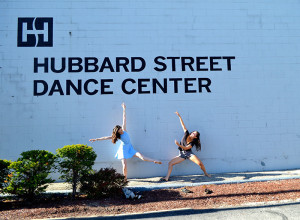

On left, one of my closest friends from school, Lena Oren, came into Chicago for the summer intensive. Here we are dancing outside of Hubbard Street’s building, located on Jackson Boulevard and Racine Avenue. On right, the summer intensive concluded with an in-studio showcase, which offered my fellow dancers and me the opportunity to perform the repertory excerpts we had been studying for the past four weeks.
Beyond working and dancing at Hubbard Street’s building in the West Loop, I found that living in Chicago in the summertime was delightful. I grew up in Milwaukee, but hanging out on Lake Michigan’s lakefront never gets old. The Brown Line to Kimball route of the Chicago Transit System (the “L,” as locals call it) offers stunning views of the downtown Loop. The Taste of Chicago food festival, the Bean, Buckingham Fountain, and the city’s diverse and characteristic neighborhoods gave me much to do and explore. I had the priceless company of my older sister, who has lived in Chicago for more than a year now, and my best friend from school, who traveled from California to participate in the summer intensive at Hubbard Street with me. We ate out, walked the lakefront, hung around Clark Street, and attended street festivals, parades, and shows. I also used my weekends to attend dance classes and shows anywhere and everywhere in an attempt to acquaint myself with Chicago’s greater dance community.
I subleased two apartments during my three months there: one from a coworker at Hubbard Street, a 15-minute walk from the West Loop (where Hubbard Street’s building is located) in the quaint, historic Little Italy neighborhood of Chicago. The other sublet was more of a gamble. I lived with a stranger far uptown at Lawrence and Clark, a location that required me to learn how to navigate Chicago’s public transportation system each morning in order to get to work. In terms of my mysterious roommate, I actually got very lucky. I lived with a Chicago and dance enthusiast who showed me around the city, specifically the characteristic area of Lincoln Square, and has become one of my closest friends.
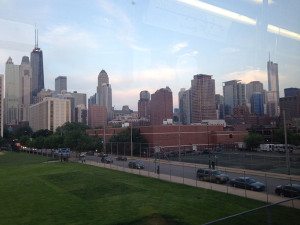
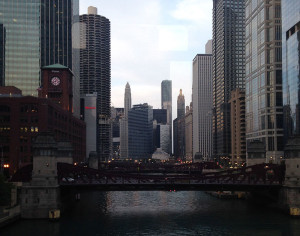
On left, Chicago skyline from the Brown Line train north to Kimball. On right, downtown loop of Chicago from the Brown Line train north to Kimball.
And so, both inside and outside of Hubbard Street’s building, my summer in Chicago fulfilled and excited me day-by-day. The pressure of having new assignments and needing to catch on to the operations of a new department at Hubbard Street every week honestly made me a little anxious on Monday mornings (especially during my week in marketing, an area in which I had no previous experience). The variety of choreography I studied during the intensive also required me to be flexible, in more ways than one! So I learned to adapt to the diversity in both the office and the studio, and to do my best with all that was thrown my way.
My to-do list throughout those three months was anything but monotonous. Every morning when I arrived at the building, I knew I could be asked to do just about anything to help make dance happen. I rolled out a marley floor. I organized video archives. I sifted through the dusty costume cage in the back warehouse. I wrote and I researched. I faxed and I answered phones. I brainstormed and I went to meetings. I ordered and picked up gifts for the choreographer on opening night. I ran the video camera at technical and dress rehearsals. I went to dance class and came back day after day with more sore spots and bruises. I cared to finesse the individual details and qualities of each piece I was taught. I tried assuming nothing and being curious all summer long, and it was an impactful approach to my working to bridge my student experience with becoming a professional.
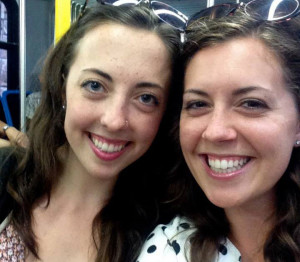
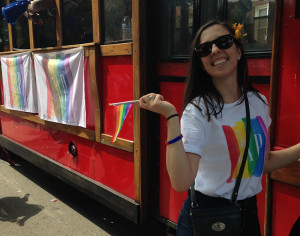
On left, my Chicago-based older sister and I on a city bus. On right, Here I am at the Chicago Pride Fest, one of the many summer city activities I soaked up. Others included Taste of Chicago, the Blackhawks Stanley Cup Victory Parade, and free concerts at the outdoor Jay Pritzker Pavilion.
I left Chicago with a big-picture understanding of the many factors that make up the dance powerhouse that is Hubbard Street Dance Chicago. The organization offers more than 70 classes a week to the public, rents studio space out to dance projects and companies, holds special dance education workshops through The Parkinson’s Project and The Autism Project, educates young dancers in a variety of dance styles, practices dance outreach in Chicago’s public schools, develops early career artists through the second company, and produces professional shows that feature a wide range of choreography on national and international stages.
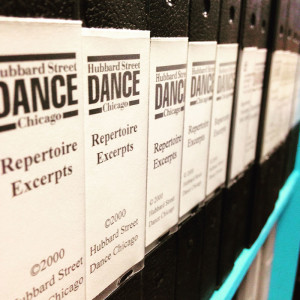
I spent one afternoon getting lost in Hubbard Street’s media room, which contains rehearsal and performance footage that dates back to the 1980s.
I now have a personal understanding of the effort, talent, teamwork, and dedication it takes to maintain such an umbrella for dance. The company dancers themselves are no less exceptional. They are thoughtful, articulate, versatile movers who appear almost invincible in the studio and in performance. When they grace the stage of the Power Center this October, you’ll see what I mean.
Hubbard Street Dance Chicago returns to Power Center with an evening of works by choreographer William Forsythe on October 27, 2015.
Interested in more? UMS Artist Services Manager Anne Grove was once company manager of Hubbard Street Dance Chicago. Read our interview with Anne.
Student Artwork Inspired by Hubbard Street Dance Chicago
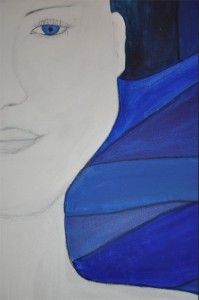
Meredith Giltner, teacher at Carpenter Elementary (our DTE School of the Year!) shared this artwork with us, created by her students in response to Hubbard Street Dance Chicago’s school day performances.
UMS TalkOut Project: Hubbard Street Dance Chicago
Editor’s note: This post is a part of a series. View all TalkOut events.
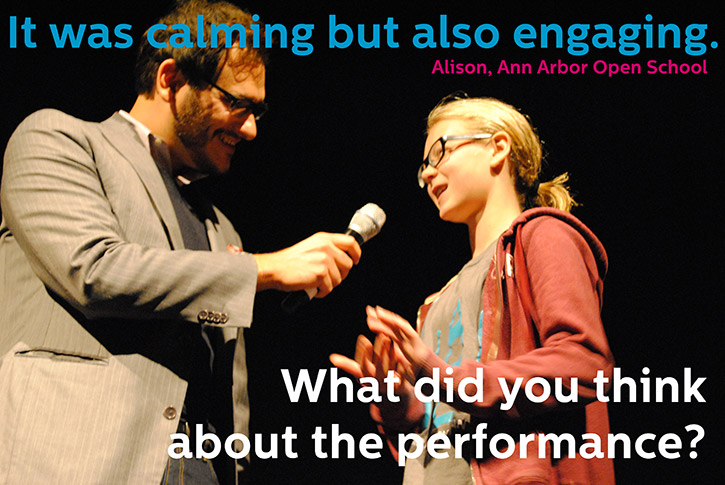
Photo: Alison McCarthy from the Ann Arbor Open School (6th Grade) shares her thoughts.
Our TalkOut project for K-12 students involves speaking and listening (two core K-12 learning competencies) and creating a sharing ripple that allows the experience of a UMS School Day Performance to live on in the minds and hearts of young people and that helps students make connections between the arts on stage and their classroom.
This “TRIMTAB” pilot project was developed with guidance from Eric Booth at the Kennedy Center Partners in Education Program’s February 2013 Annual Meeting by the Michigan 1997 Team: Ann Arbor Public Schools (Robin Bailey), UMS (Jim Leija and Omari Rush), and the Washtenaw Intermediate School District (Jennifer Scott-Burton).
TalkOut encompasses the entire UMS School Day Performance experience. Prior to the start of the show an onstage host provides the entire audience with a framing question. At the end of the performance, two students (selected by UMS and school teachers pre-performance) are invited on stage to share their thoughts and ideas with the entire audience. The feedback is immediately celebrated, captured with photos and audio, and passed on to others for shared reflection.
Here, Lindsay Zinbarg (Saline High School, 12th Grade) participates in TalkOut at the Hubbard Street Dance Chicago performance (interviewed on stage by UMS’s Jim Leija):
Interested in learning more? Download the TalkOut Project Description
Your Dance Make Me…../……Make Me Dance Submissions
Last year we collected your Hill Auditorium memories. This year we’re collecting your thoughts about dance because we’re focusing especially on dance this season.
For a closer look at dance, check out:
- UMS Tweet Seats at opening night dance performances
- Free Q&As with artists on opening night dance performances
- “You Can Dance” workshops
- UMS Night School
Here’s what you have to say about things that make you dance and things that dance inspires you to do.
Watch for your chance to fill out these post-it notes at select dance performances including Hubbard Street Dance Chicago (9/28), Ballet Preljocaj (11/2), Compagnie Käfig (2/15), and Wendy Whelan: Restless Creature (3/25).
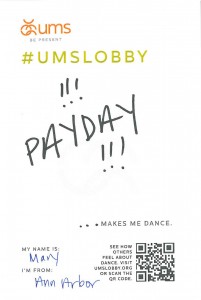
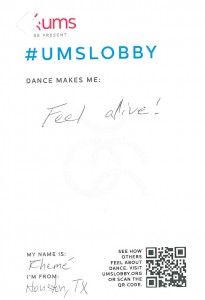
What makes you dance? What does dance inspire you to do? Do you have other questions or comments? Share them below.
Our artist services Manager Anne Grove with Hubbard Street Dance Chicago
Our artist services manager Anne Grove was once company manager with Hubbard Street Dance Chicago (who perform at Power Center September 27-28, 2013). Read our interview with Anne.
New! Educator Conversations
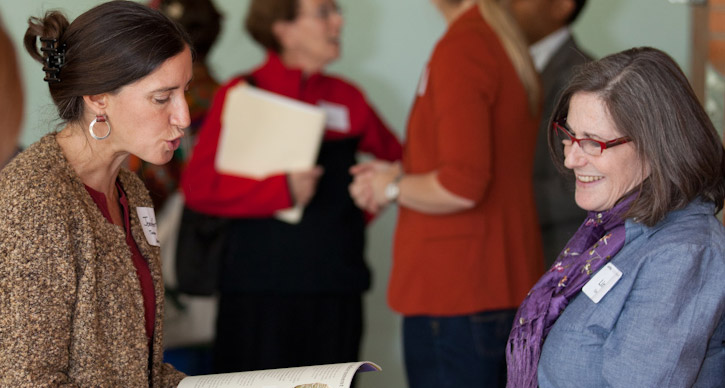
Photo: Emerson School educator Jennifer Tanau and UMS Advisory Committee member Linda Spector at a UMS reception for teachers. Photo by Mark Gjukich Photography.
This season, look for Educator Conversations on UMS Lobby.
Educators will offer suggestions and answer questions about integrating UMS School Day Performances or the arts into classroom curriculum, as well as share advice on organizing a field trip to UMS. To volunteer to be a Teacher Lobby Moderator e-mail umsyouth@umich.edu.
Educator Conversations will take place around UMS School Day Performances. As soon as the conversations are live, we’ll include a link on this page.
- Hubbard Street Dance Chicago with Melissa Poli (Performance September 27)
- Ukulele Orchestra of Great Britain with Katie Ryan (Performance November 12)
- Brooklyn Rider with Emily Barkakati (Performance November 25)
- One Night in Bamako with Jeff Gaynor (Performance February 7)
- Compagnie Käfig with Dianne Dudley (Performance February 13)
- Pedrito Martinez Group with Dan Tolly (Performance March 14)
- Jazz at Lincoln Center Orchestra with Wynton Marsalis with Linda Jones (Performance March 31)
Share you questions or comments below.
Educator Conversations: Hubbard Street Dance Chicago
Editor’s note: This post is a part of a series of conversations between educators in the K-12 community. Educators will offer suggestions and answer questions about integrating UMS School Day Performances or the arts into classroom curriculum, as well as share advice on organizing a field trip to UMS. To volunteer to be a Teacher Lobby Moderator e-mail umsyouth@umich.edu. See other Educator Conversations here.
This week’s questions:
- How does a dance teacher prepare her students to see a UMS dance performance?
- How would I create a choreographic project inspired by Hubbard Street’s “One Thousand Pieces”?
- What are suggestions for cheap and quick (not fast food) Ann Arbor restaurants that will accommodate large groups?
This week’s moderator: Melissa Poli (Dance, Yoga, and Physical Education Teacher at Farmington High School)
Hi, my name is Melissa Poli, and I live in Ann Arbor with my husband, Andy, 14 year old daughter, Gabrielle and our part-time dog, Mina. I work at Farmington High School where I get to teach my two passions, dance and yoga. In my spare time, I attend dance concerts and festivals and lots of amazing yoga retreats in beautiful places with my family. And it’s probably obvious that my favorite quote is, “Let the beauty of what you love be what you do.” (Rumi).
How does a dance teacher prepare her students to see a UMS dance performance?
Lots of pre-performance discussions!!! This is a “must” in order to gain an appreciation and enthusiasm for the artists and their work. Just refer to ums.org for lots of background information and video links to guide your discussions. After viewing an excerpt from one or more of the dances, I then ask the following questions. These are referred to as “The 4 Step Critique”
- What do you see?
- How is the work organized?
- What does the dance communicate?
- How effective is the dance work?
While watching the performance (notebook in hand) students jot down the answers to these questions. We actually practice writing without looking down (so we don’t miss anything). This experience is so valuable in terms of recognizing the process of creating dances. If the overall dance works in their opinion or even if it doesn’t, at least they will be able to articulate why!
How would I create a choreographic project inspired by Hubbard Street’s One Thousand Pieces?
Or, if given the same task as choreographer Alejandro Cerrudo, how would we go about it? Would we make the same decisions? How would we interpret Marc Chagall’s American Windows?
When Alejandro Cerrudo was asked, How are you responding to Chagall’s America Windows? He replied, “The evening is inspired by the windows, but I’m not making them in dance. I might give you another perspective. You might look at the windows in a different way, after you see my piece. The windows aren’t about America. They’re about character, painting, cultural freedom, celebration.”
Related, here is my example America Windows choreography project. Students will divide into small groups and choose one panel to use as inspiration for their choreographic studies.
Each group will answer the following questions (look familiar?):
- What do you see? List everything, including the visual arts elements of line, shape, form, value/shading, texture, space, color.
- How is the work organized?
- What does the art communicate?
Students will then create dances based on the answers.
What are suggestions for cheap and quick (not fast food) Ann Arbor restaurants that will accommodate large groups?
My favorite place by far has been the Big Boy on Plymouth Road. We get the buffet in order to accommodate everybody. I collect the money ahead of time, including tips, and pay all at once. Call ahead to reserve. Or, If you have enough chaperons, the kids really like dividing up to visit various restaurants near State Street and Liberty Street.
What do you think? Share your responses or questions in the comments section below.
UMS Living Archive: Julie Wallace, U-M Alumna
Over the past several years, Julie Wallace has worked as a member of our student staff in the UMS ticket office and in the office of the President, providing enthusiastic and creative support to UMS’s ongoing endeavors. She is a lover of dance and musical theater, and she describes in this video how UMS continued to nurture that love of dance. Julie notes, “I couldn’t imagine college without UMS.”
Hubbard Street Dance Chicago: Your Questions Answered!
Editor’s note: Hubbard Street Dance Chicago return to Ann Arbor on October 27, 2015.
To close out this season’s Dance Series, we had three mesmerizing performances by Hubbard Street Dance Chicago on April 22-24. For a long time, members of our staff had wanted to try out the concept of a “post-it wall” in the lobby for a performance. We thought it would be interesting to try this with a dance company because dance can inspire so many different feelings, interpretations, and questions.
Throughout the weekend, Company dancers and touring staff loved seeing your comments on the wall (as did other audience patrons and we)! There were three different opportunities to respond:
-Describe tonight in six words or less.
-What was your favorite piece?
-Leave a question for the Company.
Glenn Edgerton, Hubbard Street Dance Chicago’s Artistic Director, was kind enough to answer all the questions you left on the wall. Thanks, Glenn!
Last dance (Walking Mad): why not end on the high note? The slow piece at the end wore the audience down…you could have had a standing ovation without the slower dance.
Often choreographers like to contrast their work and basically “keep it real”. Once they give you that feeling of excitement and euphoria their thought process is to bring you back down to reality and emotionally give you one last profound statement to contemplate.
If you are sad during a performance do you have to smile?
As a dancer, you also have to be an actor. If the part requires a smile, then yes you have to be able to perform the work with the emotional content as it is intended.
Did another company perform Bitter Suite? Sounds familiar.
Jorma Elo has also made a work for Aspen Santa Fe Ballet called “Red Suite” but not sure if they ever performed in Ann Arbor. (UMS Note: Neither of these works have ever been performed under UMS auspices.)
Was the volume to the music for Walking Mad turned down on purpose? Why?
Yes, the music volume gets turned down to create the image of the music coming from another part of a house or space. Just prior to this moment the dancers are with party hats and dancing through the doorway evoking a party scene. Once they pass through, the space changes and traps the female dancer in another space and then the music is meant to seem like it is coming from a distance from where the party is happening on the other side of the wall.
Is this the only theater you perform at where the audience posts questions?
Yes, this was a unique idea of UMS.
How many times a week do you practice?
We rehearse five days a week. When there are performances however this might turn into six days a week.
How do you synchronize so accurately when the music is so nondescript from measure to measure?
Practice, practice, practice. But actually, once you work with music for a while it starts to become more apparent where the landmarks are at least.
When you turn off your cameras and cell phones during the performances how do the photographers get pictures for the brochure?
We have individual agreements with photographers to get pictures during technical rehearsals and sometimes in performances; consequently they are the only ones with the rights to keep their cameras turned on.
How many shows did you perform so far?
In Ann Arbor we had four performances in total—one was a school show.
Why not have the choreographers explain what they are trying to express?
The idea is to have your imagination cultivated during the performance and to find the expression that fits for you and your life.
Which dance was your favorite to perform, and why?
Since I am the artistic director I can’t answer that for the dancers but I know from my past and know from our current dancers, typically the most challenging work, physically and emotionally, becomes a dancer’s favorite; although as a director they are all supposed to be equally important.
Why not have a more descriptive breakdown of each program included in your guide?
This is a similar question from before; the description should be your description and not told to you but rather for you to create and imagine.
Why did you choose to portray violence?
If that is your image from what you saw that is certainly valid. I can’t imagine however, you thought it was all violent. We always try to show a wide range of emotions and physicality in one evening.
Are you all friends?
Yes, we are all friends. As with any group you are often closer to some than others but everyone gets along very well with each other.
Are your bows choreographed as part of the dance?
Bows are often the last thing to be rehearsed but yes they are planned.
How many weeks does it take to learn a piece?
Learning a piece and creating a piece are two different things. To learn a piece already existing can take as little as two weeks to four. Creating a new work for a third of an evening (approx. 25 min) usually takes four to five weeks.
How old were you when you started taking dance lessons?
Me personally, I was six. Each dancer has a different past and process to their dancing career.
How long have most of you been dancing?
Most of our dancers started at a young age, typically around eleven, but occasionally you will see a dancer who started at four and others who started at eighteen.
Do you struggle with injuries?
Injuries are an unfortunate reality to being a dancer. You are always trying to go further with your movements to increase your range of movement and dynamic qualities therefore strength issues and structural issues become a definite struggle.
Dude, wasn’t it awkward to have your family see you topless and still convince them you’re not that kind of dancer? –>Are you an idiot?
This was a two part comment. The subsequent post-it, asking the other messenger if he was an idiot, drew an arrow to the first question. I actually have strong opinions about both of these statements. Even the word topless makes me cringe. That part of the piece was meant to express vulnerability and a nakedness of raw emotion, not to be gratuitous or sexual in any way. The men did not wear shirts for the entire piece and therefore this moment when the woman doesn’t either, evokes a sense of equality and a double standard of nudity in our society. The second statement is a judgment that also makes me cringe. Each individual has their interpretation of the experience which I would hope is respected although I encourage each audience member to go deeper into his thoughts to find an aspect that makes him see beyond the obvious.
Do you eat fish?
I’m assuming this is a comment from a piece we have had in the repertory in the past called “Minus 16” where one of the dancers has spoken text, which he asks, “Do you eat fish?”
Is the chemistry between partners difficult to foster or does it come naturally?
Sometimes as a director you get an immediate sense of who will have chemistry with another and then there are other times surprises come forward in a very holistic way; each pairing is different.
How has your experience with the company resembled your image of Hubbard Street at the start?
I can only speak from my perspective but I have found that the company is much more down to earth and that the organization breathes a sense of humbleness and enthusiasm for the work whereas you might guess the opposite in such an internationally respected company.
When will you perform here next time?
As often as possible; there are no dates set as of now.
How is it decided which pieces will be performed together?
The pieces are discussed with the presenters of the venue to get a sense of their audience and what will fit best with them. There is always an attempt to show a versatile program with contrasting music, movement qualities, emotional qualities and production values.
What are you wearing on your feet?
Most often ballet shoes but some pieces are danced bare foot and others require a characterization in the costuming which would dictate what a dancer wears such as street shoes or dance sneakers.
When will you come to Rochester NY?
As often as possible; there are no dates set as of now.
Was the girl really topless? Sorry, color blind!
In the last pas de deux of 27’ 52”, the female and male dancers were bare chested.
Do you weight train?
Some dancers do weight training to enhance their strength during their spare time but it is not part of their work day.
Are you ever tempted to laugh while performing?
All the time. Usually some funny element happens during a performance but it’s up to the dancer to be so concentrated in their part and not let those things phase them or react to them.
Does your mother know what you’re up to?
If this is in regard to the nudity, the answer is yes. I believe every parent is extremely proud to have their child expressing art at this level.
Are you nervous before a show?
Always.
How long do you work on a show?
Each show is different depending on how often the pieces have been danced in the past, but about a month to five weeks is typical to prepare a new program.
How would you describe the earthquake in Chile?
The earthquake in Chile was surely devastating. We were meant to tour there prior to our engagement in Ann Arbor until this happened. Now we are scheduled for next spring 2011 to tour there. You could imagine an earthquake to be depicted in the final moments of 27’ 52”.
What does “staged by” mean after “choreographed by” is already listed?
The choreographer will generally send someone they designate to teach a piece on our dancers which means this person gets credit for “staging” the work whereas the choreographer still remains as the creator of the piece.
Here are some of our favorite responses to the other questions. Thanks to everyone who participated–we loved hearing from you!


